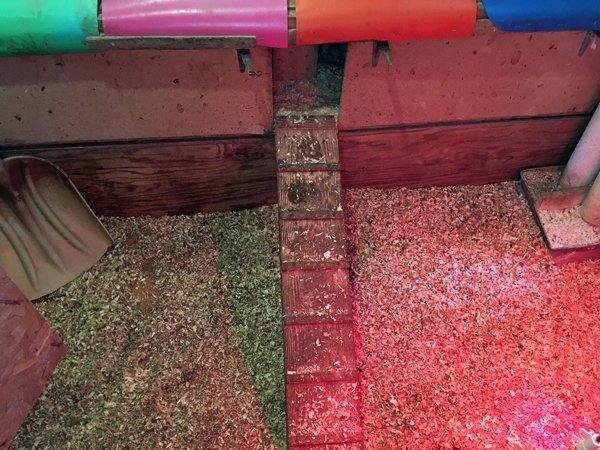
My husband was feeling better on Wednesday, so he suggested we get the cleaning of the coop over with. It wasn’t smelling bad, due to plenty of carbon added in the form of wood shavings.
We used deep bedding in our coop. Because there are too many birds in too small a space, the bedding builds up fast and needs to be removed at least once over the winter. That is what had happened. It was up to 8” from the bottom roost, which is 18” from the floor.

It’s only bad under the roosts as that’s where chickens do most of their eliminating. Over by the nestboxes in wasn’t very deep or dirty.

This shows how deep it was and the layers of manure and bedding
I wear a respirator when I work in the coop due to respiratory problem. It’s always a good idea to wear at least a mask, due to the dust a coop has. Because I had the respirator on, I could not smell if there was ammonia as I dug out under the roosts.
The people door to the coop is small so the system is that I am inside digging and loading a 30 gallon tote through the door. My husband drags the full tote out of the entryway and substitutes an empty one. Then he dumps the tote in the pigs’ stall for them to turn into compost. Only we had no pigs this year, so there’s a good bit of bedding in there now…
So I relied on him to tell me if he smelled ammonia. It wasn’t until I got into the other corner where it was deepest and had the heaviest manure, he said he smelled a little ammonia. This is good information as ammonia is damaging to the birds lungs. We’d done a good job keeping the ammonia in check.

We had linoleum on the floor and up the walls for many years. But it eventually wore out and we’ve yet to replace it. You can see the damage the manure is doing to the wood without the linoleum to protect it.

There’s also this wet spot where the waterer hangs. Hopefully we will find the energy to strip the coop and put new linoleum down this year. Perhaps a project for my intern and I when it’s warmer.

While we worked, the supervisor snoozed in the weak sunlight.

Rooster is the top most bird
The rest of the supervisors were tossed outside, where Rooster was practicing his crowing. But he’s got a quiet crow and I could only hear him now and again, against the running hen commentary about the service.

This next part is the really dusty bit and one must wear at least a mask from here on. I spread diatomaceous earth on the floor, against the walls and on the roosts. This helps neutralize and remaining odor and ammonia. It also protects against mites and pests.

Next I cleaned out the old bedding from the nestboxes. Turns out there was a hen in there the whole time. She supervised the emptying. I found 6 eggs in there.

The Australorp from the nestbox
When I started re-bedding the boxes, she didn’t like it and tried to escape. My husband caught her and put her out in the pen.

Clean and bedded nestboxes

Once I have all the bedding out of the nestboxes, I spread it in front of them. Then I get clean wood shavings to put under the roosts and the rest of the coop. It takes the best part of 2 bales to re-bed the nestboxes and coop.

While I was doing that, my husband refilled the grit and oystershell feeders and cleaned the waterer.

Then we let the hens in to do their inspection. And inspect they do! You can see it’s still very dusty in there.
The sleds on top of the nestboxes keep the hens from perching there. They’d make an awful mess of the top, and we have to open it every day for egg collection.
So that was the big project for Wednesday. I only had to run errands in the afternoon and make a meatloaf and salad supper.
love your posts @goldenoakfarm, farming is tough work, but so worth it.
Downvoting a post can decrease pending rewards and make it less visible. Common reasons:
Submit